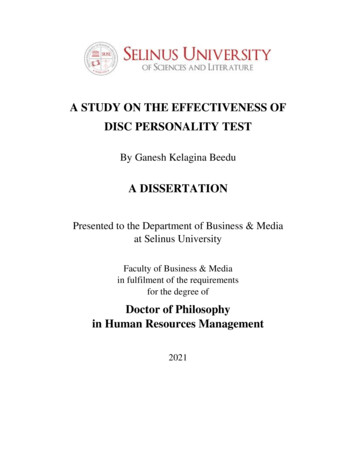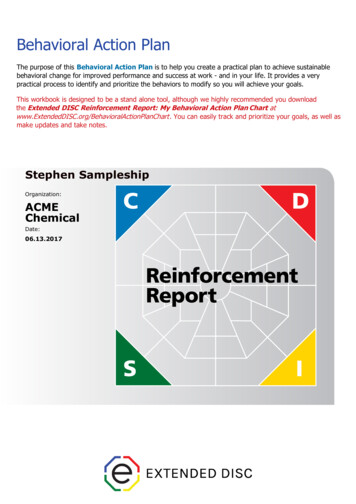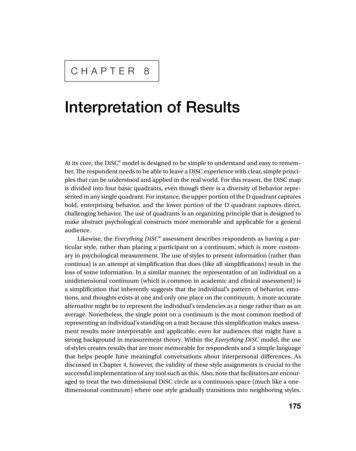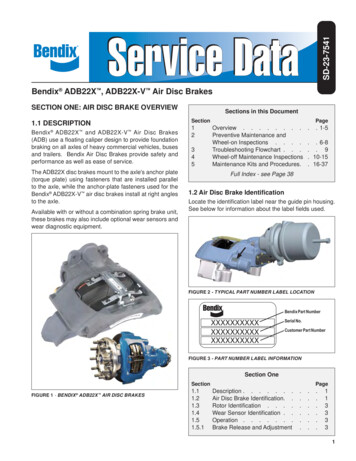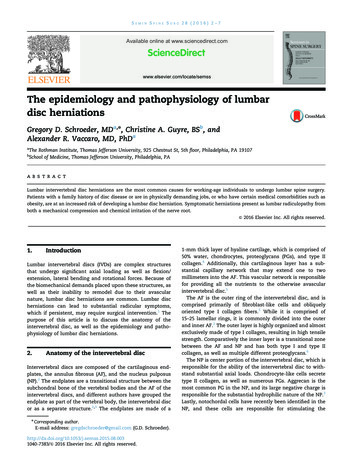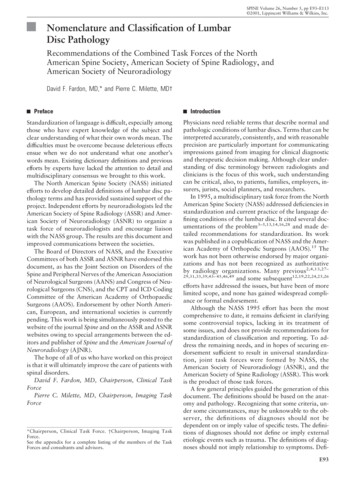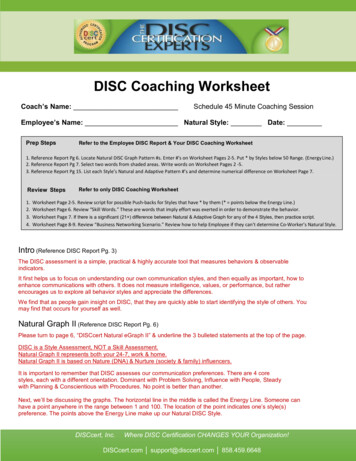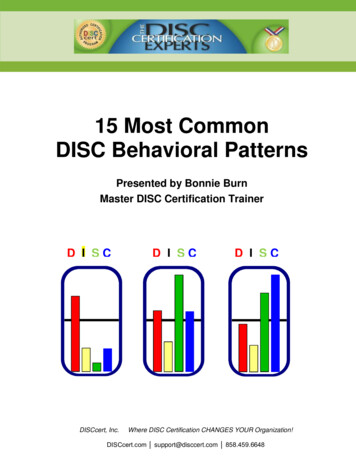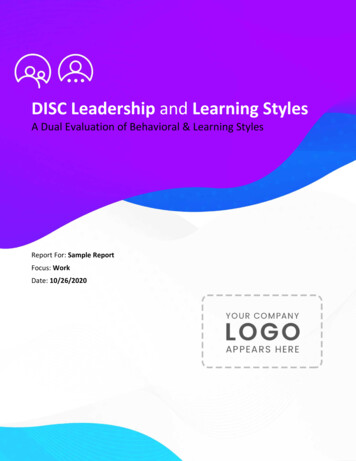
Transcription
DISC Leadership and Learning StylesREPORT FOR Sample ReportDISC Leadership and Learning StylesA Dual Evaluation of Behavioral & Learning StylesReport For: Sample ReportFocus: WorkDate: 10/26/2020Copyright 2020A24x7All rights reserved.Company Name Here 206-400-6647 www.YourWebsite.com1
DISC Leadership and Learning StylesREPORT FOR Sample ReportTable of ContentsIntroduction to the DISC and Learning Styles Online Report .3PART I Understanding YourselfGeneral Characteristics.4Your Strengths: What You Bring to the Organization .6Your Motivations (Wants) and Needs.7Your Motivations: Ideal Work Environment .8Your Behavior and Needs Under Stress.9Communication Plans .10Potential Areas for Improvement.13Summary of Your Style .14Word Sketch: Adapted Style.15Word Sketch: Natural Style.16Your Personalized eGraphs.17The 12 Behavioral Tendencies .18Your Behavioral Pattern View.23PART II Application of DISC StylesApplication, Application, Application .24Overview of the Four Basic DISCstyles .25How to Identify Another Person’s Behavioral Style.26What is Behavioral Adaptability?.28How to Modify Your Directness and Openness .29Tension Among the Styles .30How to Adapt to the Different Behavioral Styles .33Building and Maintaining Rapport Throughout The Leadership Process .37PART III Learning StylesIntroduction.51Your Results .53Using Learning Styles .54Your Individual Score .55Attending .56Translating .57Relating.58Understanding .59Summary.60The Effective Learning Cycle .61Pulling It All Together .65My Contract For Change.66So Now What? .68Disclaimer .70Copyright 2020A24x7All rights reserved.Company Name Here 206-400-6647 www.YourWebsite.com2
DISC Leadership and Learning StylesREPORT FOR Sample ReportIntroduction to the DISC and Learning Styles Combined ReportCongratulations on your decision to take the DISC and Learning Styles Combined Assessment.Many of us grew up believing the wisdom of treating others the way you would like to be treated — the Golden Rule. Wesoon realized that another practical rule to live by seemed to be what Dr. Tony Alessandra calls The Platinum Rule — Treatothers the way THEY want to be treated.With this personalized and comprehensive DISC and Learning Styles Combined report, you have the tools to help youbecome a better you and help you behave more maturely and productively. Then you can develop and use more of yournatural strengths, while recognizing and improving your limitations. This report concentrates on your natural tendenciesthat influence your behavior and values/motivations.DISC STYLESHistorical, as well as contemporary, research reveals more than adozen various models of our behavioral differences, but many shareone common thread: the grouping of behavior into four basiccategories. Our DISC System focuses on patterns of external,observable behaviors using scales of directness and openness thateach style exhibits. See the table below. Because we can see andhear these external behaviors, it becomes much easier to “read”people. This model is simple, practical, and easy to remember and use.ADAPTABILITYTends to be direct and guardedIn addition to understanding your DISC style, Part II (Application of DISC Styles) covers behavioral adaptability - ways youTends to be direct and opencan apply your style strengths or modify your style weaknesses in order to meet the needs of a particular situation orindividual. Social scientists call it social intelligence (EIQ) which may be just as important, or even more important, as yourTends to be indirect and openIntelligence Quotient (IQ) in being successful in today’s world.LEARNING STYLESTends to be indirect and guardedHow we learn is a topic of thousands of books and articles that are written on the subject from hundreds of differentperspectives. One particular, but large, foundational part of this subject area is learning styles. Your Learning Styles Profileis designed to measure your learning style in most situations.This is done in four categories:1. ATTENDING2. TRANSLATING3. RELATING4. UNDERSTANDINGIn your learning styles profile, you are scored in all four categories and most, if not necessarily all, of the subscales. In thisreport we will look at these four categories in more detail.Copyright 2020A24x7All rights reserved.Company Name Here 206-400-6647 www.YourWebsite.com3
DISC Leadership and Learning StylesREPORT FOR Sample ReportPART I Understanding YourselfGeneral CharacteristicsThe narration below serves as a general overview of your behavioral tendencies. It sets the stage for the report whichfollows, and provides a framework for understanding and reflecting on your results. We've occasionally provided somecoaching ideas so that you can leverage your strengths whenever possible to maximize your personal success.Sample, you score like those who maintain a high sense of urgency in most things they do. You are always thinking aboutmore efficient or effective ways of getting things done. This urgent tempo can help propel you and your team to newsuccesses, but may sometimes cause frustration on your part when faced with setbacks.You tend to be assertive and responsive to creative ideas and solutions. When in creative mode, you may tend to withdrawa bit and process information internally. Once the decision has been made, or the solution created, you emerge as a moreassertive and mission-focused leader. Sample, you score like those who push the envelope of their own creativity, and tendto lead their teams to optimal performance. To get the most out of this trait, be certain to display a more people-orientedside at times, so that others on the team can see this side of you as well.You make day-to-day operational decisions very quickly and easily. You put substantially more time, effort, and caution intolarger decisions. You score like some who tend to be worriers, in a good sense, because of the level of detail and quality ofthought behind the important decisions you make. At times, you may present yourself with "double-bind" situations:"damned if you do, and damned if you don't." You may reduce stress in these types of situations by seeking input fromtrusted advisors.Careful analysis of your response pattern indicates that you may tend to have dichotomous ambitions: On one hand, youare driven to achieve quick, visible results, but you are equally motivated by strong quality control and perfection. In anideal world, these drives could work in harmony, but in reality, they might well prove detrimental to the result. You maysometimes seek quick results at the expense of quality, or vice versa.Copyright 2020A24x7All rights reserved.Company Name Here 206-400-6647 www.YourWebsite.com4
DISC Leadership and Learning StylesREPORT FOR Sample ReportGeneral Characteristics (continued)Your decisiveness and reaction time may suffer due to a desire to investigate all facets of a problem and all potentialsolutions before making a final decision. Your detail-oriented nature may work against you by creating an internalbottleneck.You tend to handle assertive and aggressive people in a blunt and critical way. If someone is "dishing it out," you can take itand also dish it right back to them. This may be somewhat intimidating to those in the workplace who prefer a softerapproach, so be careful not to overreact. In your communication with others, you tend to provide just the facts andinformation needed to get the job done, or the question answered. Sometimes, however, it may be necessary to toleratesome off-topic discussion in order to build a rapport with others on the team.When in high thought-processing gear, you may be somewhat restrained in sharing ideas or expressing feelings. You scorelike those who may be perceived by others as somewhat cool or aloof. This is especially true when you are faced withdecisions of very high importance. You tend to internalize the thought processes and not share them with others as you areevaluating the possibilities. By opening up a bit, you might reduce the potential for internal stress, and also be perceived asmore of a collaborative decision maker.You like to be perceived as a pacesetter -- one who comes up with new ideas and creative solutions. This theme will emergein other parts of this report due to its importance. You bring a creative spin to the way you solve problems and findsolutions. You have the ability to evaluate the whole range of possibilities, and provide deep mindshare on the decisionsyou make. This comes from both your decision-making ability and your deep concern for details.Copyright 2020A24x7All rights reserved.Company Name Here 206-400-6647 www.YourWebsite.com5
DISC Leadership and Learning StylesREPORT FOR Sample ReportYour StrengthsWhat You Bring to the OrganizationYou are likely to display your strength characteristics rather consistently. For the most part, these qualities tend to enhanceyour effectiveness within your organization. Work Style Preferences provide useful insights as you work in a job or as youwork together on a team or family project. They are the talents and tendencies you bring to your job. Check the two mostimportant strengths and the two most important work style tendencies and transfer them to the Summary of Your Stylepage.Your Strengths: You are able to find solutions quickly, with a high degree of quality control.You are able to make decisions having the bottom-line in mind.You put hard work and heavy effort into finding the best possible answers to questions or problems.You maintain a strong, businesslike focus on problems, ideas, and solutions.You tend to be a strong agent of change.You consider many alternatives, theories, and possibilities in your problem-solving approach.You are a very creative thinker and innovator.Your Work Style Tendencies That You Bring to the Job: You enjoy developing new systems and procedures to increase efficiency or quality control.You motivate others on the team with a sense of competition and urgency.You are motivated to be creative and tend to become bored with routine work.You are able to look at a project from a "big picture" perspective, while keeping track of the details and minutiaethat contribute to each step.You want to be seen as assertive, and at the vanguard of leadership regarding new ideas and solutions.You sometimes hesitate in making decisions due to a desire to investigate all facets of a problem, and all potentialsolutions.You are motivated to be an initiator of creative new ideas, and may be seen as an agent of change within anorganization.Copyright 2020A24x7All rights reserved.Company Name Here 206-400-6647 www.YourWebsite.com6
DISC Leadership and Learning StylesREPORT FOR Sample ReportYour Motivations (Wants) and NeedsWhat motivates you? People are motivated by what they want. What do you really want? Our behaviors are also driven byour needs. Each style has different needs. If one person is stressed out, they may need quiet time alone; another may needsocial time around a lot of people. Each is different and simply meeting their needs. The more fully our needs are met, theeasier it is to perform at an optimal level. Check the two most important motivators (wants) and the two most importantneeds and transfer them to the Summary of Your Style page.You Tend to Be Motivated By: Freedom from control and close scrutiny. A lack of freedom implies a lack of trust.High standards of quality that all members of the team honor and support.Direct, factual answers to questions, supported by accurate data.Time to analyze facts and data prior to making a final decision.Time to react to sudden changes, and to analyze the impact on overall quality.Efficient methods which get things done faster, without sacrificing quality.New experiences, and new challenges to meet.People With Patterns Like You Tend to Need: A minimum of oversight, interference, and organizational politics getting in the way of the creative processes.To seek more input from others for a more effective team cooperation.To verbalize more of your reasons for decisions, and to include others in the decision-making process.Opportunities to use your professional expertise to solve problems by finding creative solutions.To be able to trust the competence and high standards of others on the team.Fewer daily critical decisions, as you may hesitate when under too much pressure due to the desire for a highquality result.To focus on reaching closure on projects, as you tend to resist finalizing because there is always something thatcould be improved.Copyright 2020A24x7All rights reserved.Company Name Here 206-400-6647 www.YourWebsite.com7
DISC Leadership and Learning StylesREPORT FOR Sample ReportYOUR MOTIVATIONS Ideal Work EnvironmentEverybody is motivated however; they are motivated for their own reasons, not somebody else’s reasons. Byunderstanding your motivations, you can create an environment where you are most likely to be self-motivated. Check thetwo most important environment factors and transfer them to the Summary of Your Style page.You Tend to Be Most Effective In Environments That Provide: Freedom from external pressure, while allowing for self-imposed pressure and urgency.Challenging assignments that are both detailed and wide in scope.Power and authority to make decisions and create change.Freedom to create in new and different ways.Support of some occasional vacillation in decisions or ideas.Opportunities for one to work alone, and to think things through.Support which allows you to focus maximum effort on the job tasks, and not to be concerned with social protocol.Copyright 2020A24x7All rights reserved.Company Name Here 206-400-6647 www.YourWebsite.com8
DISC Leadership and Learning StylesREPORT FOR Sample ReportThe C StyleUnder Stress - Perceptions, Behavior and Needs for the CStress is unavoidable. The perceptions of our behavior may have a significant impact on our effectiveness - both in how we perceiveourselves and how others perceive us. The way we behave under stress can create a perception that is not what we intend. Thedescriptions below of perceptions by others may seem somewhat extreme at times (especially if our behavior is an over-extendedstrength that becomes a weakness or limitation). As you understand these perceptions more clearly, you are able to modify yourbehavior to maximize your own effectiveness and ensure that others see you as you intend.Potential Self Perception: Under Stress, May be Perceived by Others:Quality control drivenCautious agent of changeCreative solutions to problemsResults-driven CondescendingAloof and bluntCreates double-bind situationsVacillatesUnder Stress You Need: Understanding of principles and detailsGuarantees that you are rightA slow pace for "processing" informationYour Typical Behaviors in Conflict: Since you tend to focus on quality and your own high standards, you may become demanding in order to ensurecompliance.You often resort to various indirect techniques to manipulate the environment to make it more favorable to yourposition. You may resort to little known rules and procedures, the literal meaning of regulations, the use ofcommittees, and other indirect approaches.You appear to acquiesce to the demands of others and, thus, avoid conflict. In reality, however, you are often justwithdrawing to prepare for a future, probably covert, attempt to reestablish your position.Strategies to Reduce Conflict and Increase Harmony: Include all the people involved with a project in your decision-making process. Ask for their suggestions as well astheir data.Be sure to share the reasoning behind your decisions. Failure to do so makes them seem arbitrary.Be more open with your friends and coworkers, sharing your feelings, needs and concerns with them.Copyright 2020A24x7All rights reserved.Company Name Here 206-400-6647 www.YourWebsite.com9
DISC Leadership and Learning StylesREPORT FOR Sample ReportCommunication Tips and Plans for OthersThe following suggestions can help others who interact with you understand and be aware of your communicationpreferences. To use this information effectively, share it with others and also discuss their preferences.Check the two most important ideas when others communicate with you (do’s & don’ts) and transfer them to the Summaryof Your Style page.When Communicating with Sample, DO: Motivate and persuade Sample by pointing out objectives and expected results.Be specific about what's needed, and who is going to do it.Stick to business matters only -- small talk or charm won't be appreciated.Give Sample time to verify the issues and potential outcomes.Do your homework, because Sample's homework will already be done.Beware of indecision, and be sure to keep the "data gate" open for more information.Give Sample the opportunity to express opinions and make some of the decisions.When Communicating with Sample, DON’T: Whine about all of the work you have to do.Provide incomplete or unclear directions or instructions.Use unreliable evidence or testimonials.Try to develop "too close" a relationship, especially too quickly.Forget or lose things necessary for the meeting or project.Fail to follow through. If you say you're going to do something, do it.Leave things up in the air, or decide by chance.Copyright 2020A24x7All rights reserved.Company Name Here 206-400-6647 www.YourWebsite.com10
DISC Leadership and Learning StylesREPORT FOR Sample ReportCommunication Plan with the DOMINANT StyleCHARACTERISTICS:Concerned with being #1Think logicallyWant facts and highlightsStrive for resultsLike personal choicesLike changesPrefer to delegateWant others to notice accomplishmentsNeed to be in chargeTendency towards conflictSO YOU Show them how to win, new opportunitiesDisplay reasoningProvide concise dataAgree on goal and boundaries, the support or get out of their wayAllow them to “do their thing,” within limitsVary routineLook for opportunities to modify their workload focusCompliment them on what they’ve doneLet them take the lead, when appropriate, but give themparametersIf necessary, argue with conviction on points of disagreement,backed up with facts; don’t argue on a “personality” basisCommunication Plan with the INFLUENCING StyleCHARACTERISTICSConcerned with approval and appearancesSeek enthusiastic people and situationsThink emotionallyWant to know the general expectationsNeed involvement and people contactLike changes and innovationsWant others to notice THEMOften need help getting organizedLook for action and stimulationSurround themselves with optimismWant feedback that they “look good”SO YOU Show them that you admire and like themBehave optimistically and provide upbeat settingSupport their feelings when possibleAvoid involved details, focus on the “big picture”Interact and participate with themVary the routine; avoid requiring long-term repetition by themCompliment them personally and oftenDo it togetherKeep up a fast, lively, paceSupport their ideas and don’t poke holes in their dreams; showthem your positive sideMention their accomplishments, progress and your other genuineappreciationCopyright 2020A24x7All rights reserved.Company Name Here 206-400-6647 www.YourWebsite.com11
DISC Leadership and Learning StylesREPORT FOR Sample ReportCommunication Plan with the STEADY StyleCHARACTERISTICSConcerned with stabilityThink logicallyWant documentation and factsLike personal involvementNeed to know step-by-step sequenceWant others to notice their patientperseveranceAvoid risks and changesDislike conflictAccommodate othersLook for calmness and peaceEnjoy teamworkWant sincere feedback that they’reappreciatedSO YOU Show how your idea minimizes riskShow reasoningProvide data and proofDemonstrate your interest in themProvide outline and/or one-two-three instructions as youpersonally “walk them through”Compliment them for their steady follow-throughGive them personal assurancesAct non-aggressively, focus on common interest or neededsupportAllow them to provide service or support for othersProvide a relaxing, friendly atmosphereProvide them with a cooperative groupAcknowledge their easygoing manner and helpful efforts, whenappropriateCommunication Plan with the CONSCIENTIOUS StyleCHARACTERISTICSConcerned with aggressive approachesThink logicallySeek dataNeed to know the processUtilize cautionPrefer to do things themselvesWant others to notice their accuracyGravitate toward quality controlAvoid conflictNeed to be rightLike to contemplateSO YOU Approach them in an indirect, nonthreatening wayShow your reasoningGive data to them in writingProvide explanations and rationaleAllow them to think, inquire and check before they makedecisionsWhen delegating, let them check procedures, and other progressand performance before they make decisionsCompliment them on their thoroughness and correctness whenappropriateLet them assess and be involved in the process when possibleTactfully ask for clarification and assistance you may needAllow them time to find the best or “correct” answer, withinavailable limitsTell them “why” and “howCopyright 2020A24x7All rights reserved.Company Name Here 206-400-6647 www.YourWebsite.com12
DISC Leadership and Learning StylesREPORT FOR Sample ReportPotential Areas for ImprovementEveryone has some possible struggles, limitations or weaknesses. Oftentimes, it’s simply an overextension of your strengthswhich may become a weakness. For example, a High D style’s directness may be a strength in certain environments, butwhen overextended they may tend to become bossy.Check the two most important areas you are committed to improve upon and transfer them to the Summary of Your Stylepage.Potential Areas for Improvement: You have a strong need for perfection and may not be satisfied until it has been reached.You may tend to work in rapid bursts, followed by periods of quiet reflection. This style may be confusing to otherswho might prefer a more consistent approach.You may like to work under pressure, and thus you put others under unwelcome pressure sometimes.You tend to be unconcerned about social poise and may appear somewhat abrupt or aloof toward others withoutbeing aware of this. You could build more bridges by showing more sensitivity to their feelings.Others may have difficulty keeping up with your opposing desires for quick, yet perfect results.You may need some improvement on your communication skills. It is important to share ideas with others on theteam, allowing them to be a "sounding board" for your thoughts.You may appear indecisive to some because of the need to re-examine evidence, or even wait for new evidenceprior to making decisions.Copyright 2020A24x7All rights reserved.Company Name Here 206-400-6647 www.YourWebsite.com13
DISC Leadership and Learning StylesREPORT FOR Sample ReportSummary of Sample Report’s StyleCommunication is a two-way process. Encourage others to complete their own DISCstyles Online Assessment and then sharethe Summary Sheet with each other. By discussing preferences, needs and wants of the people you work with, socialize withand live with, you can enhance these relationships and turn what might have been a stressful relationship into a moreeffective one just by understanding and applying the DISCstyles information. Complete the worksheet below from theprevious pages of this report.YOUR STRENGTHS: WHAT YOU BRING TO THE ORGANIZATION1.2.YOUR WORK STYLE TENDENCIES1.2.YOUR MOTIVATIONS (WANTS)1.2.YOUR NEEDS1.2.YOUR MOTIVATIONS: IDEAL WORK ENVIRONMENT1.2.COMMUNICATION DO’S & DON’TS1.2.POTENTIAL AREAS FOR IMPROVEMENT1.2.Copyright 2020A24x7All rights reserved.Company Name Here 206-400-6647 www.YourWebsite.com14
DISC Leadership and Learning StylesREPORT FOR Sample ReportWORD SKETCH - Adapted StyleDISC is an observable “needs-motivated” instrument based on the idea that emotions and behaviors are neither “good” nor “bad.” Rather,behaviors reveal the needs that motivate that behavior. Therefore, once we can accurately observe one’s actions, it is easier to “read” andanticipate their likely motivators and needs.This chart shows your ADAPTED DISC Graph as a “Word Sketch.” Use it with examples to describe why you do what you do and what’simportant to you when it comes to (D)ominance of Problems, (I)nfluence of People, (S)teadiness of Pace, or (C)onscientiousness ofProcedures. Share more about the specific needs that drive you in each area of FOCUS. If your DISC intensity scores at levels 1 and 2, youremotions and needs are the opposite of those at Levels 5 and 6 in that area.DISC FocusDISCProblems / TasksPeoplePace (or Environment)ProceduresNeedsChallenges to solve,AuthoritySocial relationships,Friendly environmentSystems, Teams, StableenvironmentRules to follow, Data toanalyzeEmotionsAnger, ImpatienceOptimism, TrustPatience, NonExpressionsFear, Concern being takenadvantage of/lack ofcontrol being left out, loss ofsocial approval sudden change/loss ofstability and security being criticized/loss ofaccuracy and qualityFearsCopyright 2020A24x7All rights reserved.Company Name Here 206-400-6647 www.YourWebsite.com15
DISC Leadership
DISC STYLES Historical, as well as contemporary, research reveals more than a dozen various models of our behavioral differences, but many share one common thread: the grouping of behavior into four basic categories. Our DISC System focuses on patterns of external, observable behaviors using scales of directness and openness that each style .
